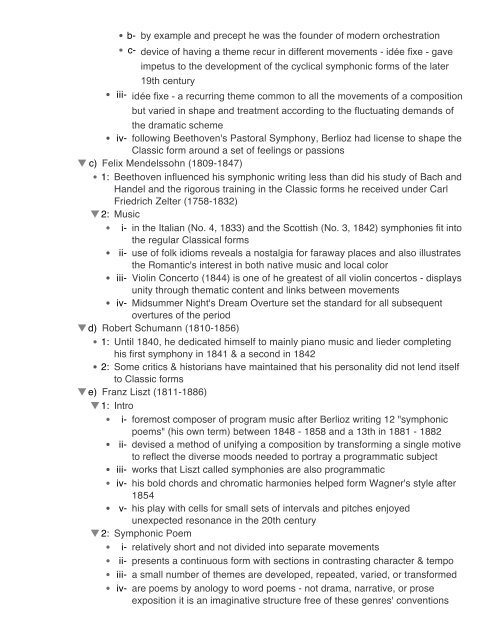An Outline of The History of Western Music Grout ... - The Reel Score
An Outline of The History of Western Music Grout ... - The Reel Score
An Outline of The History of Western Music Grout ... - The Reel Score
You also want an ePaper? Increase the reach of your titles
YUMPU automatically turns print PDFs into web optimized ePapers that Google loves.
- by example and precept he was the founder <strong>of</strong> modern orchestration<br />
c- device <strong>of</strong> having a theme recur in different movements - idée fixe - gave<br />
impetus to the development <strong>of</strong> the cyclical symphonic forms <strong>of</strong> the later<br />
19th century<br />
iii- idée fixe - a recurring theme common to all the movements <strong>of</strong> a composition<br />
but varied in shape and treatment according to the fluctuating demands <strong>of</strong><br />
the dramatic scheme<br />
iv- following Beethoven's Pastoral Symphony, Berlioz had license to shape the<br />
Classic form around a set <strong>of</strong> feelings or passions<br />
c) Felix Mendelssohn (1809-1847)<br />
1: Beethoven influenced his symphonic writing less than did his study <strong>of</strong> Bach and<br />
Handel and the rigorous training in the Classic forms he received under Carl<br />
Friedrich Zelter (1758-1832)<br />
2: <strong>Music</strong><br />
i- in the Italian (No. 4, 1833) and the Scottish (No. 3, 1842) symphonies fit into<br />
the regular Classical forms<br />
ii- use <strong>of</strong> folk idioms reveals a nostalgia for faraway places and also illustrates<br />
the Romantic's interest in both native music and local color<br />
iii- Violin Concerto (1844) is one <strong>of</strong> he greatest <strong>of</strong> all violin concertos - displays<br />
unity through thematic content and links between movements<br />
iv- Midsummer Night's Dream Overture set the standard for all subsequent<br />
overtures <strong>of</strong> the period<br />
d) Robert Schumann (1810-1856)<br />
1: Until 1840, he dedicated himself to mainly piano music and lieder completing<br />
his first symphony in 1841 & a second in 1842<br />
2: Some critics & historians have maintained that his personality did not lend itself<br />
to Classic forms<br />
e) Franz Liszt (1811-1886)<br />
1: Intro<br />
i- foremost composer <strong>of</strong> program music after Berlioz writing 12 "symphonic<br />
poems" (his own term) between 1848 - 1858 and a 13th in 1881 - 1882<br />
ii- devised a method <strong>of</strong> unifying a composition by transforming a single motive<br />
to reflect the diverse moods needed to portray a programmatic subject<br />
iii- works that Liszt called symphonies are also programmatic<br />
iv- his bold chords and chromatic harmonies helped form Wagner's style after<br />
1854<br />
v- his play with cells for small sets <strong>of</strong> intervals and pitches enjoyed<br />
unexpected resonance in the 20th century<br />
2: Symphonic Poem<br />
i- relatively short and not divided into separate movements<br />
ii- presents a continuous form with sections in contrasting character & tempo<br />
iii- a small number <strong>of</strong> themes are developed, repeated, varied, or transformed<br />
iv- are poems by anology to word poems - not drama, narrative, or prose<br />
exposition it is an imaginative structure free <strong>of</strong> these genres' conventions<br />
v- content and form may be suggested by a picture, statue, play, poem, scene,<br />
personality, etc., but the subject is converted into music without specific





